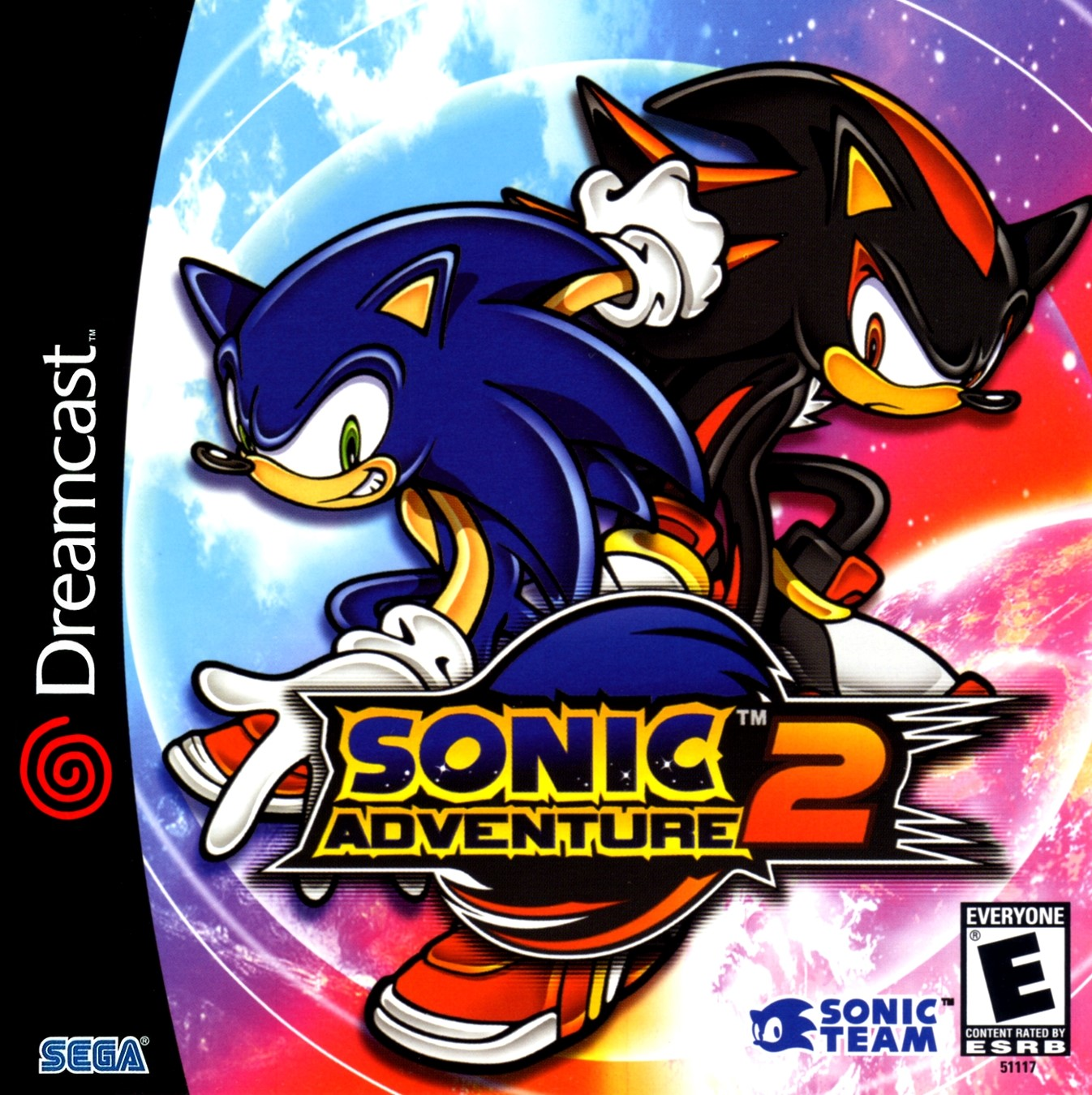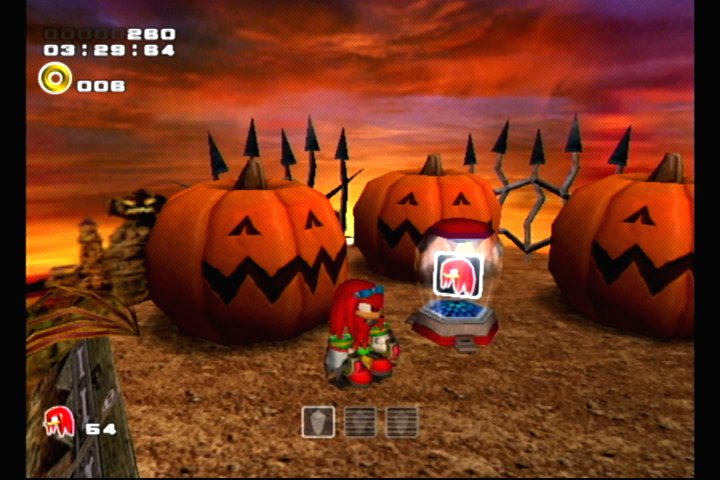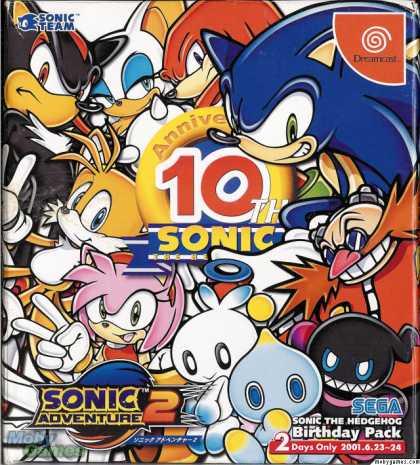
Sonic Adventure 2 is a video game for the Dreamcast video game console. It is the sequel to Sonic Adventure.
The game was released in North America on June 19, 2001 and in Japan and Europe on June 23, 2001 for the Dreamcast to mark the 10th anniversary of the release of the original Sonic the Hedgehog. The game introduces two new playable characters, Shadow the Hedgehog and Rouge the Bat, and is also one of the few Sonic games to officially feature Doctor Eggman as a playable character. It is also the first game in the series in which the latter character is wholly referred to as "Eggman" in the West, and the "Robotnik" name was adopted in Japan for other related characters.
Following shortly after Sega's departure from console manufacturing, the game was ported to the Nintendo GameCube under the title Sonic Adventure 2: Battle. It was released in Japan on December 20, 2001, North America on February 11, 2002, and Europe on May 3, 2002. This version was the first Sonic the Hedgehog game on a Nintendo system, having been released ten days before Sonic Advance in Japan, and it became one of the highest-selling games on that system.
Gameplay
Sonic Adventure 2 follows the same basic principles of previous games in the series. Within most stages are rings, which will protect the player from dying so long as one is held by the player. The Tails and Doctor Eggman stages, in exception, employ a health bar which is reloaded by gathering rings. Item capsules are also located within the stages which provide the player bonuses. Each character has obtainable power-ups which grant them new abilities, such as destroying metal boxes or playing mystical melodies.

The new feature of grinding was a big part in Sonic and Shadow's levels.

Debut of the self proclaimed "Ultimate Life Form" Shadow the Hedgehog.
Single-player
The single player mode can be played between two parallel storylines, the "Hero" story mode and the "Dark" story mode; the player has the option of advancing in either one at any time. The "Hero" story premieres Sonic, Knuckles, Tails, while the "Dark" story premieres Shadow, Rouge, and Dr. Eggman. Respectively, each hero character plays similarly to its prospective dark character. Levels advance in the same order for each storyline.
Levels featuring Sonic or Shadow are regular platformers, designed in much the same way as they were in Sonic's levels in Sonic Adventure, wherein the player's primary objective is simply to reach the end of the level. Levels with Tails or Dr. Eggman are based on shooting, allow the player to control a mechanized robot walker and shoot their way to the end, reminiscent of E-102 Gamma's stages in Sonic Adventure. The Knuckles and Rouge levels are based on hunting, with the characters scouring their levels for three keys, usually shards of the Master Emerald, much like Knuckles' levels in Sonic Adventure. Interspersed between the levels are various bosses, which one particular character must fight. The main story line can only be finished when both "Hero" and "Dark" story modes are finished, and an extra "Final" story mode is introduced where the player must use all 6 characters back to back to achieve the true ending.

Knuckles in Pumpkin Hill.
Two-Player Mode
A two-player mode is also provided in Sonic Adventure 2, where the complementary characters are able to play against one another in racing levels, shooting levels, and treasure-hunting levels. Stages from the main one-player game are available in this mode, albeit slightly altered for competitive play. The goals for each stage are to defeat the other player by completing a task first: racing levels require the player to reach the Goal ring; shooting levels end when one Walker runs out of energy either by being destroyed by the competitor or falling off the stage; and the treasure hunting levels are won when one character gets two of the three Emerald shards.
Special features in this two-player mode are unlocked by meeting certain conditions in the single player mode. Additional characters include familiar characters from previous games, but they must be unlocked in the original Dreamcast version: Amy and Metal Sonic complement Sonic and Shadow, Chao and Dark Chao complement Tails and Eggman, and Tikal and Chaos 0 complement Knuckles and Rouge. Alternate costumes are usable only in two player mode and vary in each version of the game, as do the conditions required to unlock the costumes.

Metal Sonic and Amy Rose in 2 player mode.
Chao and Chao World
The animal Chao exist in an area held separate from the rest of the game called Chao World. Chao are meant to be raised and taken care of in the same manner as with human babies. Chao World incorporates three main areas: the Chao Gardens (three in total, but two must be unlocked by the player), the Chao Kindergarten, and the Chao Race Lobby.
The player finds and raises Chao in the Chao Garden. When Chao hatch, they crawl and are unable to swim. They get their nutrition from knocking the fruit off trees. When a Chao begins to grow up, it will eventually go into a cocoon stage in which it will transform. Depending on how each Chao in the garden was raised and treated during childhood, it can become a generic Chao or a Light or Dark Chao. As soon as a Chao transforms, if it has become a Light or Dark Chao, it will unlock for the player the Hero Garden or the Dark Garden, which are vertically positioned in Chao World similar to Heaven and Hell. "Chaos Drives" and hidden animals can be found in the action stages and can be given to Chao during childhood to boost the Chao's stats and physical attributes.
The Chao Kindergarten is where the player can take the Chao to have it named, have its health and stats checked, and have it learn new skills. Also, in the GameCube adaptation only, rare items can be purchased at the Black Market using the Rings collected during normal gameplay. The Black Market is also in Sonic Adventure DX: Director's Cut, and with more game Emblems earned, rarer merchandise becomes available on the Market.

Tails with Chao in the Hero Garden.

Evil and Hero Chao type.

Your Chao can perform in Chao Races or even Chao Karate.
GameCube differences
The Nintendo GameCube adaption of Sonic Adventure 2, called Sonic Adventure 2: Battle, was released on December 10, 2001 in Japan, February 12, 2002 in North America, and on the GameCube's launch (May 3, 2002) in Europe. This game changed a large portion of raising Chao, the artificial life form available in both Sonic Adventure and Sonic Adventure 2. A Chao's stats can be viewed from within the game. The player can transfer one Chao from Sonic Adventure 2: Battle to the "Tiny Chao Garden" section in Sonic Advance, Sonic Advance 2, and Sonic Pinball Party with the GCN-GBA Link Cable. If a Game Boy Advance is connected without a GBA game inserted, a version of the Tiny Chao Garden can be copied temporarily into the Game Boy Advance's memory. Chao Karate was also introduced in this version. The Chao's stats are used against a computer-controlled opponent to fight in a fighting game style, but with minimal influence from the player and very little in terms of actual Karate. The layouts of all three Chao Gardens were also changed slightly, with Sonic Adventure 2 Battle's Chao Gardens being significantly smaller than those of the original Dreamcast version.
Development
Sonic Adventure 2 was developed by Sega Studio USA, the former United States division of Sonic Team, and published by Sega. The game was directed by longtime series contributor Takashi Iizuka and developed over the course of approximately one and a half years. The environments of the game were inspired by San Francisco, California—the location of Sega Studio USA—and the United States as a whole. The game was designed to be action-oriented as opposed to the slower-paced, more story-based Sonic Adventure.
Sega hyped Sonic Adventure 2 both as the final Sonic game for the Dreamcast and as marking the tenth anniversary of the original Sonic the Hedgehog.
Plot
After discovering the existence of a secret weapon mentioned in the diary of his grandfather, Gerald Robotnik, Dr. Eggman infiltrates a high-security G.U.N. facility in search of it. This "weapon," a black hedgehog named Shadow who claims that he is the "Ultimate Life Form," offers to help Eggman take over the world, telling him to rendezvous with him at the abandoned Space Colony ARK with more Chaos Emeralds. Shadow proceeds in stealing one of the emeralds, and G.U.N. officials mistake him for Sonic. Sonic is apprehended shortly after he confronts Shadow, who demonstrates to Sonic the Chaos Control technique.
Meanwhile, Knuckles confronts both Rouge the Bat and Eggman, who each attempts to steal the Master Emerald. Knuckles shatters the Master Emerald to prevent this, and proceeds to search for the scattered shards and restore the Emerald. While Rouge also intends to collect the shards for personal benefit, she must also accomplish a mission for the government to spy on Eggman. This mission also leads her to the ARK, where Shadow relays to Eggman his plan to use the Chaos Emeralds to charge a superweapon on the ARK called the Eclipse Cannon to take over the world. To accomplish this, Shadow and Eggman recruit Rouge to assist in the search of the Chaos Emeralds.
Tails and Amy infiltrate Prison Island and rescue Sonic from G.U.N., while Eggman, Shadow, and Rouge collect three Emeralds on the island, which they then destroy. Eggman then broadcasts his threats across the planet and demonstrates the cannon's level of power by destroying half of the moon. Sonic and company use the final Emerald within their possession to track down the other six, with Knuckles coming along as well. Together, the group infiltrates Eggman's base, narrowly boarding Eggman's shuttle as it launches into space. Along the ride into space, Knuckles' Master Emerald shards are spilled, and he leaves the group to collect them, encountering Rouge again. During the fight, Knuckles saves Rouge from certain death, and Rouge surrenders her collected shards, finally allowing Knuckles to restore the Master Emerald.
Onboard the ARK, Tails reveals that he has created a counterfeit Chaos Emerald designed to reverse the effects of the real Emeralds and destroy the Eclipse Cannon. Sonic goes to place the fake Emerald into the cannon when Eggman announces he has captured Tails and Amy. Sonic tries to give Eggman the fake Emerald, but at the last second Eggman traps and jettisons Sonic in an escape pod rigged with explosives. Using the fake Emerald, Sonic manages to perform Chaos Control and escape before it explodes, but Tails, thinking Sonic is dead, fights Eggman again. Shadow is sent to intercept Sonic before he destroys the Eclipse Cannon, but Sonic succeeds.
After Eggman collects all seven Chaos Emeralds, Gerald Robotnik's failsafe activates, and a recorded message is broadcast by the late Gerald explaining that the ARK will collide with and destroy the planet Earth. The two sides agree to work together to neutralize the Chaos Emeralds with the Master Emerald and stop the collision. Once there, Sonic and Knuckles encounter the Biolizard, a prototype of the Ultimate Life Form. Shadow defeats the Biolizard, allowing Knuckles to deactivate the Chaos Emeralds. However, the Biolizard revives and uses Chaos Control to fuse with the Eclipse Cannon, continuing the ARK's collision course. Using the power of the Chaos Emeralds, Sonic and Shadow transform into Super Sonic and Super Shadow and defeat the Biolizard for the final time. They then use Chaos Control to place the ARK back into Earth's orbit. In the process, however, Shadow runs out of power and plummets to Earth to his apparent death.
Development
Sonic Adventure 2 was developed by Sega Studio USA, the former United States division of Sonic Team, and published by Sega. The game was directed by longtime series contributor Takashi Iizuka and developed over the course of approximately one and a half years. The environments of the game were inspired by San Francisco, California—the location of Sega Studio USA—and the United States as a whole. The game was designed to be action-oriented as opposed to the slower-paced, more story-based Sonic Adventure.
Sega hyped Sonic Adventure 2 both as the final Sonic game for the Dreamcast and as marking the tenth anniversary of the original Sonic the Hedgehog.

The 10th anniversary birthday pack.
Music
Jun Senoue returned as head composer for this game. Like the previous game, each character received an instrumental motif that serves as their theme song. The game features performances by returning vocalists Tony Harnell, Ted Poley, Marlon Saunders, Nikki Gregoroff and Johnny Gioeli, as well as new vocalists Tabitha Fair, Todd Cooper, Paul Shortino, Everett Bradley, Kaz Silver and Hunnid-P.
Crush 40 officially debuted with the theme song Live and Learn, which plays during the main menu and the final battle.
The Sonic Adventure 2 Multi-Dimensional Original Soundtrack was produced by Jun Senoue and released by Marvelous Entertainment on August 22, 2001. The songs feature the band Crush 40, which consists of Senoue and vocalist Johnny Gioeli.
Reception
At its initial release on the Dreamcast, Sonic Adventure 2 was well-received by most fans, as well as being the recipient of very positive reviews, averaging an 89% according to critic compiler Metacritic. The game received praise for its fast-paced Sonic/Shadow levels, high-quality graphics, enhanced Chao Garden and improved gameplay mechanics from the original. Like its predecessor however, the game received criticism concerning the game's camera system. Although sites like Gamespot admitted that the camera flaws in the original Sonic Adventure were "infinitely more frustrating by comparison" the sequel was still noted to "retain some of the quirky camera work". Along with the camera flaws, the game received criticism for the Knuckles/Rouge levels, which were described by some reviewers as "confusing" and "frustrating" as well as the game having a lack of challenging boss fights. Despite these issues, the game was still a critical and commercial success with many reviewers agreeing that the game was one of the last great Dreamcast releases. IGN concluded that "If this is the last Sonic game in these declining Dreamcast years, it's satisfying to know that the DC didn't go out with a bang, but with a sonic boom."
The GameCube re-release, Sonic Adventure 2 Battle, fared considerably worse in terms of reviews, despite having no single player gameplay changes from the Dreamcast version and only an 8-month gap between their releases. Despite this, the game has sold 1.44 million units in the United States alone, making it one of the Gamecube's highest selling games. The game also sold well enough to be re-released as a Player's Choice title.
Sonic Adventure 2 has also won several awards: IGN's and GamePro's Editors' Choice Awards and GameSpy's Best of 2001: Best Dreamcast action/adventure game. ScrewAttack also rated Sonic Adventure 2 as the fifth best Dreamcast game.
From the game-play, storyline, characters, voice actors, music, chao, and anything related you want to discuss for Sonic Adventure 2 goes here.
Last edited by Rhys the Hedgehog on Fri Apr 15, 2011 7:14 am; edited 3 times in total



